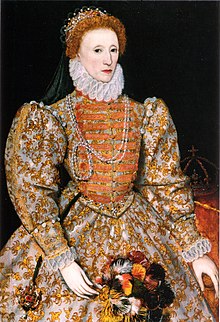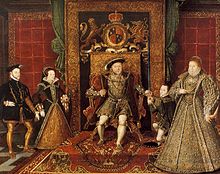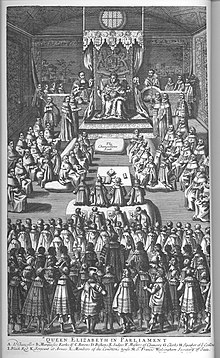Elizabethan Religious Settlement
Some modifications were made to appeal to Catholics and Lutherans, including giving individuals greater latitude concerning belief in the real presence of Christ in the Eucharist and permission to use traditional priestly vestments.Calvinists split between conformists and Puritans, who wanted to abolish what they considered papist abuses and replace episcopacy with a presbyterian church government.[1] Under Elizabeth's half-brother, Edward VI, the Church of England became more explicitly Protestant, projecting a "restrained" Calvinism, in the words of historian Christopher Haigh.[5][6] The Mass, the central act of Catholic worship, was condemned as idolatry and replaced with a Protestant communion service, a reminder of Christ's crucifixion.Her government's goal was to resurrect the Edwardian reforms, reinstating the Royal Injunctions of 1547, the 1552 Book of Common Prayer, and the Forty-two Articles of Religion of 1553.[22] In February, the House of Commons passed a Reformation Bill that would restore royal supremacy, the Edwardine Ordinal, and a slightly revised 1552 prayer book.Under the bill, only opinions contrary to Scripture, the General Councils of the early church, and any future Parliament could be treated as heresy by the Crown's ecclesiastical commissioners.[34] The rubric provided instructions for clerical vestments, stating that until the Queen ordered otherwise ministers were to "use such ornaments as were in use by the authority of Parliament in the second year of the reign of King Edward VI".[39] In his "Puritan Choir" thesis, historian J. E. Neale argues that Elizabeth wanted to pursue a conservative policy but was pushed in a radical direction by a Protestant faction in the House of Commons.[39] In 1559, Elizabeth was still unsure of the theological orientation of her Protestant subjects, and she did not want to offend the Lutheran rulers of northern Europe by veering too far into the Reformed camp.The Queen never forgave John Knox for writing The First Blast of the Trumpet Against the Monstruous Regiment of Women, which denounced female monarchs, and the Reformation in Geneva was tainted by association.These included injunctions allowing processions to take place at Rogationtide and requirements that clergy receive permission to marry from the bishop and two justices of the peace.While affirming traditional Christian teaching as defined by the first four ecumenical councils, it tried to steer a middle way between Reformed and Lutheran doctrines while rejecting Anabaptist thinking.One, "Of the Worthy Receiving of the Sacrament", added more detail to the church's doctrine of the Eucharist, which was described as "spiritual food" and "a ghostly substance and not carnal" made real by faith.[67] The settlement of 1559 had given Protestants control of the Church of England, but matters were different at the parish level, where Catholic priests and traditional laity held large majorities."For a while, it was possible to sustain an attenuated Catholicism within the parish framework, by counterfeiting the mass, teaching the seven sacraments, preserving images of saints, reciting the rosary, observing feasts, fasts, and customs".[72] In the early years of Elizabeth's reign, most Catholics hoped the Protestant ascendancy would be temporary, as it had been prior to Mary's restoration of papal authority.From there they wrote and published a large body of Catholic polemical work to counter Protestantism, particularly Thomas Harding, Richard Smyth, and William Allen.[78] In 1562, the Council of Trent ruled out any outward conformity or Nicodemism for Catholics: "You may not be present at such prayers of heretics, or at their sermons, without heinous offence and the indignation of God, and it is far better to suffer most bitter cruelties than to give the least sign of consent to such wicked and abominable rites.For many Protestants, clerical vestments symbolised a continued belief in a priestly order separate from the congregation,[72] and could be interpreted by Catholics as affirmation of traditional doctrines.[87] In general, the bishops considered clerical dress adiaphora and tried to find compromise, but the Queen believed that the church—and herself as supreme governor—had authority to determine rites and ceremonies.In the end, Archbishop Parker issued a code of discipline for the clergy called the Advertisements, and the most popular and effective Protestant preachers were suspended for non-compliance.In November, A Second Admonition to Parliament was published—most likely authored by Thomas Cartwright or Christopher Goodman—which presented a more detailed proposal for church reform along presbyterian lines.John Whitgift of Cambridge University, a leading advocate for conformity, published a reply in October 1572, and he and Cartwright subsequently entered into a pamphlet war.[99] Whitgift's first move against the Puritans was a requirement that all clergy subscribe to three articles, the second of which stated that the Prayer Book and Ordinal contained "nothing ... contrary to the word of God".In response, a group of conformists including Richard Bancroft, John Bridges, Matthew Sutcliffe, Thomas Bilson, and Hadrian Saravia began defending the English Church's episcopal polity more strongly, no longer merely accepting it as convenient but asserting it as divine law.[102] In response to Bridges' A Defence of the Government Established in the Church of England for Ecclesiastical Matters, an anonymous Puritan under the pseudonym Martin Marprelate published a series of tracts attacking leading conformist clergy.[107] The Church of England's dominant theology was still Calvinism, but a group of theologians associated with Bishop Lancelot Andrewes disagreed with many aspects of the Reformed tradition, especially its teaching on predestination."[109] Laudianism, however, was unpopular with both Puritans and Prayer Book Protestants, who viewed the high church innovations as undermining forms of worship they had grown attached to.From Hooker, Anglicanism "inherited its belief in the place of reason as an authority for action, its esteem for continuity over the Reformation divide, and a hospitality towards sacramental modes of thought".










History of the Church of EnglandCanalettoAnglo-Saxon ChristianityReligion in Medieval EnglandConvocations of Canterbury and YorkDevelopment of diocesesReformation (1509–1559)Reformation ParliamentDissolution of the MonasteriesThomas CranmerBook of Common Prayer (1549)Edwardine OrdinalsBook of Common Prayer (1552)Forty-two ArticlesMartyrsMarian exilesBook of Common Prayer (1559)Thirty-nine ArticlesConvocation of 1563The Books of HomiliesHistory of the Puritans under Elizabeth IVestments controversyRichard HookerFoxe's Book of MartyrsMarprelate ControversyJames I and religious issuesHistory of the Puritans under King James IMillenary PetitionHampton Court ConferenceBook of Common Prayer (1604)King James VersionArminianism in the Church of EnglandCaroline DivinesLaudianismHistory of the Puritans under King Charles IHistory of the Puritans from 1649Westminster AssemblySavoy ConferenceBook of Common Prayer (1662)Great EjectionNonjuring schismBangorian ControversyEvangelical RevivalOxford MovementDisestablishmentarianismPrayer Book CrisisHistory of the Anglican CommunionEnglandElizabeth IEnglish ReformationdoctrineliturgyAnglicanismCatholicsProtestantsHenry VIIIEdward VIMary ICatholic Churchsupreme head of the Church of EnglandReformedAct of Supremacy of 1558ParliamentSupreme Governor of the Church of EnglandAct of Uniformity 1558Book of Common PrayerLutheransreal presence of Christ in the EucharistvestmentsBook of HomiliesrecusantsCalvinistPuritanspapistepiscopacypresbyterianhigh churchArminianCharles IEnglish Civil WarRestorationvia medialow churchPhilip II of SpainCatherine of AragonannulmentChurch of Englandsupreme headProtestantCalvinismChristopher Haighjustification by faith alonecontritesalvationgood workspurgatoryprayer for the deadintercession of saintsChrist's crucifixionReal PresenceEucharisttransubstantiation1552 Book of Common PrayerChrist's spiritual presencevenerationreligious imagesrelicsiconoclasmLutheran views on Eucharistic presence1549 prayer bookprincipal secretarySir William CecilPrivy CouncilEnglish LitanyForty-two Articles of ReligionOwen Oglethorpeelevate the hostconsecrationcoronationWestminster Abbeystate opening of ParliamentAbbot Feckenhamcandlesopening Parliamentfirst ParliamentHouse of Lords